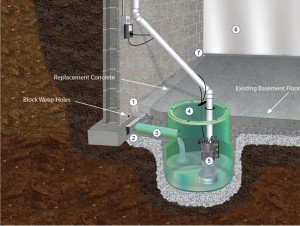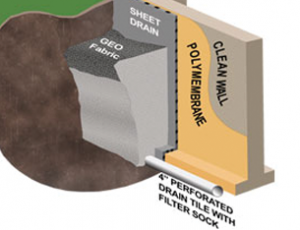Interior vs. Exterior Waterproofing
Many homeowners are familiar with the hassle and expenses of a wet basement. If moisture becomes a problem in your basement, it can cause problems. It can lead to water stains, flooding, water pooling, mold growth, rotting or rusting, and more. The issues are expensive to fix and can also be hazardous to the health and safety of you and your family.
Interior Waterproofing
However, many people are intimidated by the wide variety of options when it comes to basement waterproofing. Most waterproofing contractors offer interior and exterior waterproofing services. However, homeowners do not always know the best solution for their home. To determine which one is best for you, it is important to understand the basics of interior and exterior waterproofing.

Next, the sump pump, which is a water pump that sits inside the sump pit, pumps the water out of the basement and away from the home before it can cause damage. Most sump pumps automatically begin pumping when the water in a sump pit reaches a certain level. Many are also equipped with a battery backup to continue running without electricity, keeping your home safe and dry even in the event of a severe storm or unexpected power outage. Another component that exists in some interior waterproofing systems is a vapor barrier. Vapor barriers are damp-proofing materials such as plastic or foil sheeting that are installed along the walls to seal out moisture. They work to prevent the diffusion of water vapor through walls and floors and are often used in damp crawlspaces to keep the area dry.
An interior drainage system is excellent at removing water from a wet basement. A sound interior drainage system can reduce the risk of property loss in the event of a flood and is a good solution if you live in an area that receives a lot of rainfall throughout the year. One downfall to interior drainage systems is that they can only be used to remove water that makes its way into the basement; they are not the most effective way to prevent water from getting into the cellar in the first place.
Exterior Waterproofing
The next option is exterior waterproofing. Its two basic components are surface drainage and exterior drainage systems.

In addition to surface drainage, an exterior drainage system is a great way to keep water away from the basement. There are many key parts to a good exterior drainage system. Because it is focused around the exterior of the foundation, it is most convenient if it is installed when the home is first constructed. This is something to consider if you are planning on building a new home or adding an addition.
Another component of an exterior drainage system is a french drain or drain tile system. This system starts with a trench dug along the foundation of the home. Then, perforated drain tiles are fitted into the trench and surrounded by gravel. The entire system is covered with soil, then graded so water runs away from the foundation. This system does require some excavation, but the results can be well worth it. The drain tiles will carry water away from the foundation before entering the basement, keeping your home drier and safer.
Which Should You Choose?
There are advantages and disadvantages to both systems. The main difference between exterior and interior waterproofing is that exterior waterproofing prevents water from entering the home, while interior waterproofing removes water that has already entered the house. Check out this brief video to learn more:
Have a professional waterproofing contractor examine your home and determine the cause of the water problems. Then, the experienced team can help you decide the best course of action for your situation. The experts at Rapid Foundation Repair are happy to help you with all of your interior and exterior waterproofing needs. Contact us today for an estimate!
